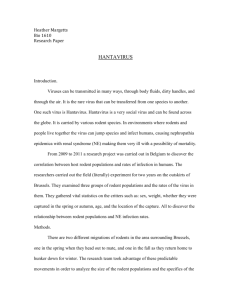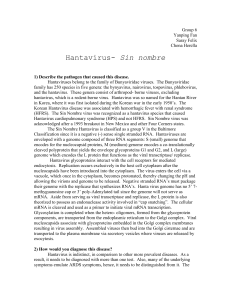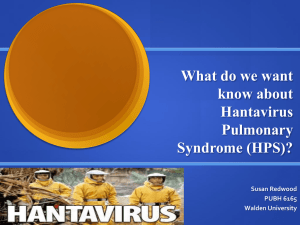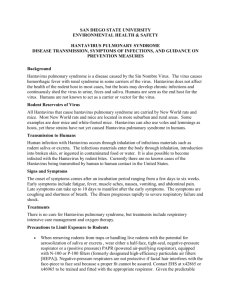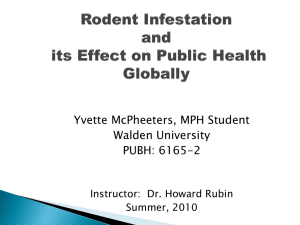Importation of laboratory mouse (Mus musculus) embryos from
advertisement
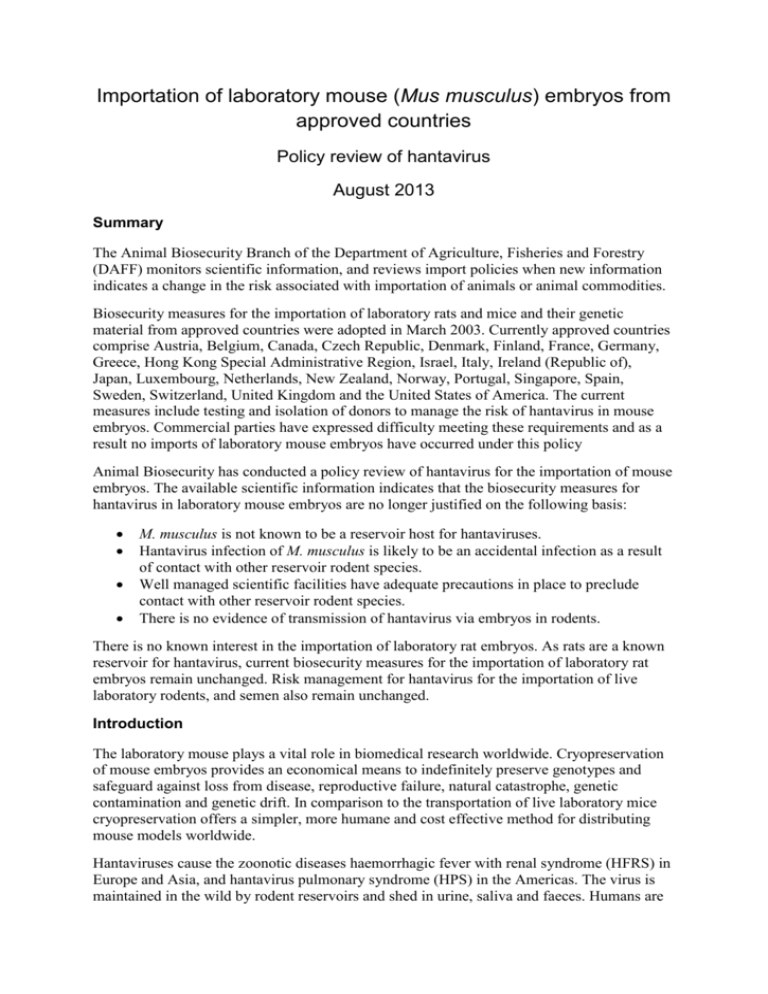
Importation of laboratory mouse (Mus musculus) embryos from approved countries Policy review of hantavirus August 2013 Summary The Animal Biosecurity Branch of the Department of Agriculture, Fisheries and Forestry (DAFF) monitors scientific information, and reviews import policies when new information indicates a change in the risk associated with importation of animals or animal commodities. Biosecurity measures for the importation of laboratory rats and mice and their genetic material from approved countries were adopted in March 2003. Currently approved countries comprise Austria, Belgium, Canada, Czech Republic, Denmark, Finland, France, Germany, Greece, Hong Kong Special Administrative Region, Israel, Italy, Ireland (Republic of), Japan, Luxembourg, Netherlands, New Zealand, Norway, Portugal, Singapore, Spain, Sweden, Switzerland, United Kingdom and the United States of America. The current measures include testing and isolation of donors to manage the risk of hantavirus in mouse embryos. Commercial parties have expressed difficulty meeting these requirements and as a result no imports of laboratory mouse embryos have occurred under this policy Animal Biosecurity has conducted a policy review of hantavirus for the importation of mouse embryos. The available scientific information indicates that the biosecurity measures for hantavirus in laboratory mouse embryos are no longer justified on the following basis: M. musculus is not known to be a reservoir host for hantaviruses. Hantavirus infection of M. musculus is likely to be an accidental infection as a result of contact with other reservoir rodent species. Well managed scientific facilities have adequate precautions in place to preclude contact with other reservoir rodent species. There is no evidence of transmission of hantavirus via embryos in rodents. There is no known interest in the importation of laboratory rat embryos. As rats are a known reservoir for hantavirus, current biosecurity measures for the importation of laboratory rat embryos remain unchanged. Risk management for hantavirus for the importation of live laboratory rodents, and semen also remain unchanged. Introduction The laboratory mouse plays a vital role in biomedical research worldwide. Cryopreservation of mouse embryos provides an economical means to indefinitely preserve genotypes and safeguard against loss from disease, reproductive failure, natural catastrophe, genetic contamination and genetic drift. In comparison to the transportation of live laboratory mice cryopreservation offers a simpler, more humane and cost effective method for distributing mouse models worldwide. Hantaviruses cause the zoonotic diseases haemorrhagic fever with renal syndrome (HFRS) in Europe and Asia, and hantavirus pulmonary syndrome (HPS) in the Americas. The virus is maintained in the wild by rodent reservoirs and shed in urine, saliva and faeces. Humans are infected when exposed to viruses in aerosols of excreta from infected rodents or by close contact with rodents. Hantavirus has also been indentified in laboratory rats and mice and has caused infection in laboratory workers. It is a potential hazard for people working with rats and mice. Hantaviruses are not known to be present in Australian rodents. Discussion Agent Hantaviruses are rodent- or shrew-borne enveloped single-stranded RNA viruses in the family Bunyaviridae (Schmaljohn et al. 1985). Hantaviruses are readily inactivated by heat, detergents, ultraviolet radiation and organic solvents (Kraus et al. 2005). At room temperature hantaviruses from dried cell culture can survive a few days (Schmaljohn 1996) and up to 15 days in rodent excreta, extending to 18 days at 4 °C (Kallio et al. 2006). Host range Over 50 hantaviruses have been identified (Hardestam 2008), with each predominantly associated with a relatively narrow host range in related rodent species. Other species (including humans) appear to be dead-end hosts. Hantaviruses form three large groups according to their rodent hosts: Murinae–, Arvicolinae– and Sigmodonitae–associated hantaviruses. The Murinae–associated Hantaan virus (HTNV), Seoul Virus (SEOV), Dobrava virus and the Arvicolinae–associated Puumala virus (PUUV) are the causative agents of HFRS. The sub family Murinae comprises old world (Asia and Europe) rats and mice including M. musculus. Sin Nombre virus (SNV), Andes virus, Black Creek Canal virus, Laguna Negra virus and other related viruses cause HPS (Zuo et al. 2008) these are associated with Sigmodonitae. The sub family Sigmodonitae includes New World (North and South America) rats and mice. Domestic rats, the Norway or brown rat (Rattus norvegicus), and the black rat (R. rattus), are the predominant reservoirs for SEOV (Jiang et al. 2008; Sun et al. 2011; Zuo et al. 2008). SEOV causes moderate HFRS in humans (Zhang et al. 2010). Evidence of infection with various hantaviruses was reported in wild caught mice (Mus musculus) in China (SEOV) (Jiang et al. 2008; Sun et al. 2011; Zuo et al. 2008), Serbia (PUUV) (Gligic et al, 1988), Yugoslavia (PUUV) (Diglisic et al. 1994) and Kuwait (PUUV, SEOV) (Pacsa et al. 2002). Other surveys of wild rodents, in the United States (Bennett et al. 1999; Kuenzi et al. 2001) and Argentina (Calderón et al. 1999) reported no hantavirus infection in M. musculus although hantavirus infection was confirmed in other rodent species. M. musculus appears to be uncommonly infected with hantaviruses. Rodent densities, behaviour and microhabitats likely affect virus distribution and potential spill over into M. musculus (Bennett et al. 1999). Geographic distribution Rats with hantavirus were first identified in Asia but infected rodents were found in many other parts of the world. Hantavirus strains borne by other species predominate in Europe and South America and are also of considerable significance in North America and Asia. Until recently, there has been limited data available on hantavirus infection in Africa, however, this may be due to confusion with other severe endemic diseases (Bi et al. 2008). 2 SEOV is generally classified as the only hantavirus with a worldwide distribution. SEOV was identified in R. norvegicus in North and South America (Bi et al. 2008) and Africa (Baddour et al. 1996). In Asia, human clinical cases caused by SEOV were mainly in China, Korea and Far East Russia. There are two papers that report seroreactivity in rodents to hantavirus in Australia (Kennett 1989; LeDuc et al. 1986). The immunofluorescent antibody test used in these studies is a relatively non-specific test and may detect antibodies to Hantaan, known Hantaan-related viruses and unknown agents related to hantaviruses (Kennett 1989). The results of further testing by virus isolation conducted by the Australian Animal Health Laboratory (AAHL) on the samples in the Kennett paper confirmed that Hantaan virus was not present (D. Middleton, AAHL, pers comm., December, 2012). In addition, there are no reports of hantavirus infection in humans in Australia. Epidemiology Hantaviruses routinely establish persistent, non-cytolytic infections in rodent hosts and are maintained in the wild by rodent reservoirs. The reservoir host rodents escape the vascular damage during persistent hantavirus infection that typically occurs in humans (Mir, 2010). Rodents shed hantavirus in faeces, saliva and urine. Each hantavirus is associated with a relatively narrow host range in related rodent species. Other species (including humans) appear to be dead-end hosts. Infection in humans occurs via inhalation of aerolised excreta or close contact with infected rodents. The average incubation period for SEOV in rats is 12-16 days (Harkness and Wagner 1995). Chronically infected and subclinical carrier rodents may excrete the virus in their urine, saliva, and faeces for months after infection. Following inoculation with SEOV, male rats have more virus present in lungs, kidneys and testes and shed virus longer than females (Klein et al. 2004). There is no indication in the literature that hantavirus can infect, or be transmitted via rodent embryos, ova or sperm. Mouse sperm are unable to be washed, and unlike embryo transfer this technology is not recommended as a way to eradicate certain diseases. In addition there is less data available on the biosecurity risks associated with mouse sperm cryopreservation. Therefore assessment of mouse sperm was not been included in this review. The Norway or brown rat (Rattus norvegicus), and the black rat (R. rattus), are the predominant reservoirs for SEOV. Hantavirus infection in rats is inapparent and routine monitoring for hantavirus in rats is recommended (Nicklas et al. 2002). Therefore amendment to the current biosecurity measures for rat embryos was not recommended. Immunology The nucleocapsid and glycoproteins of hantaviruses evoke antibody responses and induce protective immunity. (Mills et al. 1995) recommend testing wild caught rodents for hantavirus antibodies upon capture and again 30 days later as seroconversion within this period has been demonstrated. Hantavirus infection in humans is usually followed by rapid clearance of the virus. (Klingström et al. 2002) suggests the same occurs when rodents are infected with a hantavirus, which has evolved within another rodent species. In humans the duration of neutralising antibody response following exposure is prolonged. (Ye et al. 2004) demonstrated high levels of antibodies at almost four years (1 400 days) post-infection. 3 Diagnosis Diagnosis in rodents is by the detection of specific serum antibodies with enzyme immunoassay and immunofluorescent antibody assay techniques. Determination of the viral genome in rodent tissue can also be made using reverse transcriptase-polymerase chain reaction technology (Bi et al. 2008; Jonsson et al. 2010). Surveillance and monitoring in laboratory rodents Although SEOV does not cause clinical signs or pathology in laboratory rodents, the virus may compromise results obtained from research and the health of laboratory personnel. Hantavirus outbreaks among laboratory personnel were reported in several countries, including Belgium (Desmyter et al. 1983), China (Zhang et al. 2009), France (Dournon et al. 1984), Japan (Umenai et al. 1979), Republic of Korea (Lee and Johnson 1982), Singapore (Wong et al. 1988) and United Kingdom (Lloyd et al. 1984). Each of these cases was associated with laboratory rats. Transmission of hantavirus during passage of rat tumour cell lines has also been confirmed (LeDuc et al. 1985). There is a significant amount of surveillance data available for hantavirus in laboratory rodents. (Pritchett-Corning et al. 2009) reported results of samples submitted over a five year period. Submissions were received from laboratories predominantly in North America, followed by Western Europe with a small number from Asia and elsewhere. Over 144 000 samples from laboratory mice were tested for hantavirus. Testing was by ELISA or Multiplexed Fluorometric ImmunoAssay with confirmation by IFAT. No positive results were reported. The Jackson Laboratory in the United States has undertaken ongoing serological testing for hantavirus since 1999 and has not reported a positive result in mice colonies (Rob Taft, The Jackson Laboratory, pers. comm. October 2012). (Liang et al. 2009) conducted a retrospective analysis of samples submitted to the Taiwan National Laboratory Animal Center during the period 2004 to 2007. There were no positive hantavirus results in either rats or mice. Over this period there was a steady increase in demand for services from 12 laboratories in 2004 to 31 in 2007, representing approximately 10% of the 200 laboratories with animal experimentation in Taiwan at the time. In contrast, serosurveillance of laboratory mice in the Republic of Korea between 1999 and 2003 detected hantavirus antibodies in M. musculus, in 23% (3 of 13) of conventional and 3% (1 of 38) of barrier1 facilities (WON et al. 2006). As discussed earlier, in humans the duration of neutralising antibody response following exposure is prolonged. Therefore, while the results indicate exposure to hantavirus, it is not clear whether seroreactive animals remained persistently infected. The detection of seroreactivity to hantavirus in one barrier facility indicates that biocontainment procedures at this facility were ineffective. Hantavirus testing of imported live rats and mice is regularly conducted by two laboratories in Australia. This testing is conducted as part of the biosecurity measures for the importation of live mice. The number of import permits issued and tests conducted during an eight year period from one laboratory are shown in Table 1. No results were positive for hantavirus. Detailed results from the second laboratory are not available, however one positive result in laboratory mice has been reported (Ainslie Brown, DAFF, pers comm. November 2011). The 1 The term barrier refers to a general concept rather than a defined qualitative standard. A barrier is a systemic, comprehensive program for prevention of pathogen contamination. The housing facilities are only part of the program. Source animals, housing, management, monitoring and corrective action are all part of a barrier facility. 4 positive result occurred in a consignment that included imported rats and mice (Ainslie Brown, DAFF, pers comm. November 2011). No. of import permits issued by DAFF No. of hantavirus tests Rats 53 2 230 Mice 1 514 16 491 Table 1 Hantavirus testing of imported laboratory rodents (September 2003 to August 2011) Although hantavirus infection has been reported on occasion in wild and laboratory M. musculus infection with hantavirus in laboratory mice housed in accredited or bona fide facilities with adequate biocontainment is a rare event. The recommendations of the Federation of European Laboratory Animal Science Associations for health monitoring of mouse colonies in breeding and experimental units does not include routine monitoring for hantavirus. The majority of laboratories do not routinely test for hantavirus in M. musculus as the likelihood of infection is considered extremely low. Transmission via rodent embryos There is no evidence of hantavirus transmission via rodent embryos. There are grounds for considering the biological plausibility that hantaviruses may be present in the female reproductive organ of rats and mice, and that embryos and the subsequent conceptus (the embryo plus the embryonic part of the placenta and its associated membranes) may be at risk of infection. However, studies showed the uterine and ovarian tissues did not act as reservoirs or sites of hantavirus infection in the deer mouse (Peromyscus maniculatus) (Botten et al. 2000; Botten et al. 2003). Although these studies relate to a hantavirus of the Sigmodontinae group (New World rats and mice), not the Murinae group (Old World rats and mice), it is considered likely these results also apply to the sub family Murinae. Rederivation using pre-implantation embryo transfer is a method by which infected strains of laboratory animals can be cleaned or decontaminated of certain pathogens, including transmissible zoonotic diseases, before being introduced into barrier facilities. Many laboratories use rederivation when receiving mice into their colonies especially when they are of a lower or unknown health status. (Kennett 1989) recommended caesarean derivation to preserve valuable rat strains if found to be infected with hantavirus. Hantavirus-free rats were derived from infected animals by caesarean section and suckling by virus free mothers (McKenna et al. 1992). There are no reports in the current literature of transmission of hantavirus via embryo transfer in rats or mice. The Jackson Laboratory has reported no transmission of any mouse pathogens via embryo transfer. They commenced an embryo transfer program 30 years ago and currently perform 15 000 embryo transfers per year (Rob Taft, The Jackson Laboratory, pers. comm. October, 2012). 5 Conclusion Current biosecurity measures for the importation of mouse embryos include hantavirus testing and donor isolation. In many cases the embryos were collected and stored for some time making it impossible to meet the current requirements. This has resulted in no consignments of mouse embryos being imported and has increased costs and reduced availability of mouse models in Australia. The following factors are considered relevant to the biosecurity risk of hantavirus being present in imported laboratory mouse (Mus musculus) embryos. M. musculus is not known to be a reservoir host for hantaviruses. Evidence of hantavirus infection in M. musculus has been detected in wild mice. Surveillance data for laboratory mice shows that hantavirus infection is extremely rare. Hantavirus infection of M. musculus is likely to be an accidental infection as a result of contact with other reservoir rodent species. Well managed scientific facilities have adequate precautions in place to preclude contact with other reservoir rodent species. Transmission is via urine, saliva and faeces. There is no evidence of transmission of hantavirus via embryos in rodents. Embryo transfer is recommended as a method to decontaminate colonies infected with hantavirus. Based on these considerations Animal Biosecurity concludes that the biosecurity risk associated with hantavirus does not justify specific biosecurity measures for hantavirus for the importation of laboratory mouse embryos. References Baddour MM, Mourad AS, Awwad AM, Murphy JR (1996) Hantaan virus infection among human and rat populations in Alexandria. Journal of the Egyptian Public Health Association 71: 213-228. (Abstract only) Bennett SG, Webb JP, Madon MB, Childs JE, Ksiazek TG, Torrez-Martinez N, Hjelle B (1999) Hantavirus (Bunyaviridae) infections in rodents from Orange and San Diego counties, California. The American Journal of Tropical Medicine and Hygiene 60: 75-84. Bi Z, Formenty PBH, Roth CE (2008) Hantavirus Infection: a review and global update. The Journal of Infection in Developing Countries 2: 3-23. Botten J, Mirowsky K, Kusewitt D, Bharadwaj M, Yee J, Ricci R, Feddersen RM, Hjelle B (2000) Experimental infection model for Sin Nombre hantavirus in the deer mouse (Peromyscus maniculatus). Proceedings of the National Academy of Sciences 97: 1057810583. Botten J, Mirowsky K, Kusewitt D, Ye C, Gottlieb K, Prescott J, Hjelle B (2003) Persistent Sin Nombre Virus Infection in the Deer Mouse (Peromyscus maniculatus) Model: Sites of Replication and Strand-Specific Expression. Journal of Virology 77: 1540-1550. 6 Calderón G, Pini N, Bolpe J, Levis S, Mills J, Segura E, Guthmann N, Cantoni G, Becker J, Fonollat A, Ripoll C, Bortman M, Benedetti R, Enria D (1999) Hantavirus reservoir hosts associated with peridomestic habitats in Argentina. Emerging Infectious Diseases 5: 792-797. Desmyter J, LeDuc JW, Johnson KM, Brasseur F, Deckers C, van Yepersele du Strihou C (1983) Laboratory rat associated outbreak of haemorrhagic fever with renal syndrome due to hantaan-like virus in Belgium. The Lancet 32: 1445-1448. Diglisic G, Xiao S-Y, Gligic A, Obradovic M, Stojanovic R, Velimirovic D, Lukac V, Rossi CA, LeDuc JW (1994) Isolation of a Puumala-like Virus from Mus musculus Captured in Yugoslavia and Its Association with Severe Hemorrhagic Fever with Renal Syndrome. The Journal of Infectious Diseases 169: 204-207. Dournon E, Moriniere B, Matheron S, Girard PM, Gonzalez JP, Hirsch F, McCormick JB (1984) HFRS after a wild rodent bite in the Haute-Savoi--and risk of exposure to Hantaanlike virus in a Paris laboratory. The Lancet 323: 676-677. Hardestam J (2008) Hantaviruses - shedding, stability and induction of apoptosis. 2008 PhD, Karolinska Institutet, Stockholm. Harkness JE, Wagner JE (1995) Biology and medicine of rabbits and rodents, 4th edn, Williams and Wilkins, Baltimore. Jiang J-F, Zuo S-Q, Zhang W-Y, Wu X-M, Tang F, De Vlas SJ, Zhao W-J, Zhang P-H, Dun Z, Wang R-M, Cao W-C (2008) Prevalence and Genetic Diversities of Hantaviruses in Rodents in Beijing, China. The American Journal of Tropical Medicine and Hygiene 78: 98105. Jonsson CB, Figueiredo LTM, Vapalahti O (2010) A Global Perspective on Hantavirus Ecology, Epidemiology, and Disease. Clinical Microbiology Reviews 23: 412-441. Kallio ER, Klingström J, Gustafsson E, Manni T, Vaheri A, Henttonen H, Vapalahti O, Lundkvist Å (2006) Prolonged survival of Puumala hantavirus outside the host: evidence for indirect transmission via the environment. Journal of General Virology 87: 2127-2134. Kennett M (1989) Hantaan virus infection. Communicable Disease Intelligence 24: 5-7. Klein SL, Zink MC, Glass GE (2004) Seoul virus infection increases aggressive behaviour in male Norway rats. Animal Behaviour 67: 421-429. Klingström J, Heyman P, Escutenaire S, Sjölander KB, Jaegere FD, Henttonen H, Lundkvist Å (2002) Rodent host specificity of European hantaviruses: Evidence of Puumala virus interspecific spillover. Journal of Medical Virology 68: 581-588. Kraus AA, Priemer C, Heider H, Krüger DH, Ulrich R (2005) Inactivation of Hantaan VirusContaining Samples for Subsequent Investigations outside Biosafety Level 3 Facilities. Intervirology 48: 255-261. Kuenzi AJ, Douglass RJ, White D, Bond CW, Mills JN (2001) Antibody to sin nombre virus in rodents associated with peridomestic habitats in west central Montana. The American Journal of Tropical Medicine and Hygiene 64: 137-146. 7 LeDuc JW, Smith GA, Childs JE, Pinheiro FP, Maiztegui JI, Niklasson B, Antoniades A, Robinson DM, Khin M, Shortridge KF, Wooster MT, Elwell MR, Ilbery PLT, Koech D, Rosa EST, Rosen L (1986) Global survey of antibody to Hantaan-related viruses among peridomestic rodents. Bulletin of the World Health Organisation 64: 139-144. LeDuc JW, Smith GA, Macy M, Hay RJ (1985) Certified Cell Lines of Rat Origin Appear Free of Infection with Hantavirus (in ArticleType: research-article / Full publication date: Nov., 1985 / Copyright -® 1985 Oxford University Press). The Journal of Infectious Diseases 152: 1082-1083. Lee HW, Johnson KM (1982) Laboratory-Acquired Infections with Hantaan Virus, the Etiologic Agent of Korean Hemorrhagic Fever. Journal of Infectious Diseases 146: 645-651. Liang C-T, Shih A, Chang Y-H, Liu C-W, Lee Y-T, Hsieh W-C, Huang Y-L, Huang W-T, Kuang C-H, Lee K-H, Zhuo Y-X, Ho S-Y, Liao S-L, Chiu Y-Y, Hsu C-N, Liang S-C, Yu CK (2009) Microbial contaminations of laboratory mice and rats in Taiwan from 2004 to 2007. Journal of the American Association for Laboratory Animal Science 48: 381-386. Lloyd G, Bowen ETW, Jones N, Pendry A (1984) HFRS outbreak associated with laboratory rats in UK. The Lancet 323: 1175-1176. McKenna P, van der Groen G, Hoofd G, Beelaert G, Leirs H, Verhagen R, Kints JP, Cormont F, Nisol F, Bazin H (1992) Eradication of hantavirus infection among laboratory rats by application of caesarian section and a foster mother technique. Journal of Infection 25: 181190. Mills JN, Yates TL, Childs JE, Parmenter RR, Ksiazek TG, Rollin PE, Peters CJ (1995) Guidelines for Working with Rodents Potentially Infected with Hantavirus (in ArticleType: research-article / Full publication date: Aug., 1995 / Copyright -® 1995 American Society of Mammalogists). Journal of Mammalogy 76: 716-722. Nicklas W, Baneux P, Boot R, Decelle T, Deeny AA, Fumanelli M, Illgen-Wilcke B (2002) Recommendations for the health monitoring of rodent and rabbit colonies in breeding and experimental units. Laboratory Animals 36: 20-42. Pacsa AS, Elbishbishi EA, Chaturvedi UC, Chu KY, Mustafa AS (2002) Hantavirus-specific antibodies in rodents and humans living in Kuwait. FEMS Immunology & Medical Microbiology 33: 139-142. Pritchett-Corning KR, Cosentino J, Clifford CB (2009) Contemporary prevalence of infectious agents in laboratory mice and rats. Laboratory Animals 43: 165-173. Schmaljohn CS (1996) Bunyaviridae: the viruses and their replication. In Fields virology, 3rd edn, (eds. Fields BN, Knipe DM, Howley PM, Chanock RM, Melnick JL, Monath TP, Roizman B, Straus SE) pp. 1447-1471. Lippincott-Raven Publishers, Philadelphia. Schmaljohn CS, Hasty SE, Dalrymple JM, LeDuc JW, Lee HW, Von Bonsdorff CH, Brummer-Korvenkontio M, Vaheri A, Tsai TF, Regnery HL, et a (1985) Antigenic and genetic properties of viruses linked to hemorrhagic fever with renal syndrome. Science 227: 1041-1044. 8 Sun L, Shao Q, Wang Z-Q, Kang D-M, Li S-W, Li X-G, Xue F-Z, Wang J-Z, Wang J-Z (2011) Spatial structure of rodent populations and infection patterns of hantavirus in seven villages of Shandong Province from February 2006 to January 2007. Chinese Medical Journal 124: 1639-1646. Umenai T, Lee P, Toyoda T, Yoshinaga K, Horiuchi T, Lee H, Saito T, Hongo M, Nobunaga T, Ishida N (1979) Korean haemorrhagic fever in staff in an animal laboratory. Lancet I: 1314-1316. (Abstract only) WON Y-S, JEONG E-S, PARK H-J, LEE C-H, NAM K-H, KIM H-C, Hyun B-H, LEE S-K, Choi Y-K (2006) Microbiological Contamination of Laboratory Mice and Rats in Korea from 1999 to 2003. Experimental Animals 55: 11-16. Wong TW, Chan YC, Yap EH, Joo YG, Lee HW, Lee PW, YANAGIHARA RICH, Gibbs CJ, Gajdusek DC (1988) Serological Evidence of Hantavirus Infection in Laboratory Rats and Personnel. International Journal of Epidemiology 17: 887-890. Ye C, Prescott J, Nofchissey R, Goade D, Hjelle B (2004) Neutralizing Antibodies and Sin Nombre Virus RNA after Recovery from Hantavirus Cadiopulmonary Syndrome. Emerging Infectious Diseases 10: 478-482. Zhang Y-Z, Dong X, Li X, Ma C, Xiong H-P, Yan G-J, Gao N, Jiang D-M, Li H-M, Li L-P, Zou Y, Alexander P (2009) Seoul Virus and Hantavirus Disease, Shenyang, People's Republic of China. Emerging Infectious Diseases 15: 200-206. Zhang YZ, Zou Y, Fu ZF, Plyusnin A (2010) Hantavirus Infections in Humans and Animals, China. Emerging Infectious Diseases 16: 1195-1203. Zuo S-Q, Zhang P-H, Jiang J-F, Zhan L, Wu X-M, Zhao W-J, Wang R-M, Tang F, Dun Z, Cao W-C (2008) Seoul Virus in Patients and Rodents from Beijing, China. The American Journal of Tropical Medicine and Hygiene 78: 833-837. 9

